Challenges and Strategies for Literacy Learning in Aboriginal Children
VerifiedAdded on 2023/04/25
|10
|2164
|373
AI Summary
This article discusses the complexities of literacy learning for Aboriginal children and methods for supporting positive literacy outcomes. It also explores the advantages and disadvantages of phonics and whole language approaches to teaching reading and justifies why educators should provide a blended approach and how to facilitate this.
Contribute Materials
Your contribution can guide someone’s learning journey. Share your
documents today.
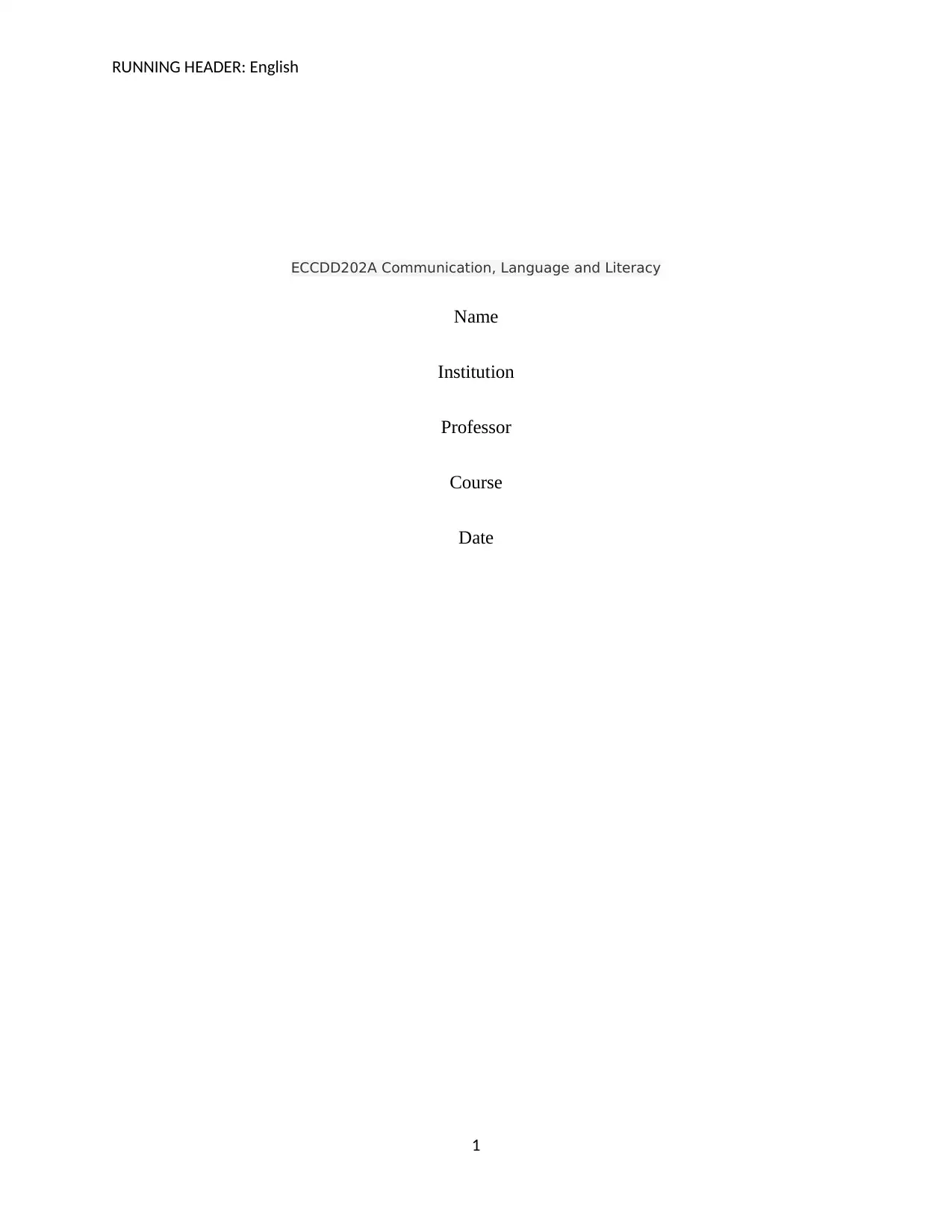
RUNNING HEADER: English
ECCDD202A Communication, Language and Literacy
Name
Institution
Professor
Course
Date
1
ECCDD202A Communication, Language and Literacy
Name
Institution
Professor
Course
Date
1
Secure Best Marks with AI Grader
Need help grading? Try our AI Grader for instant feedback on your assignments.
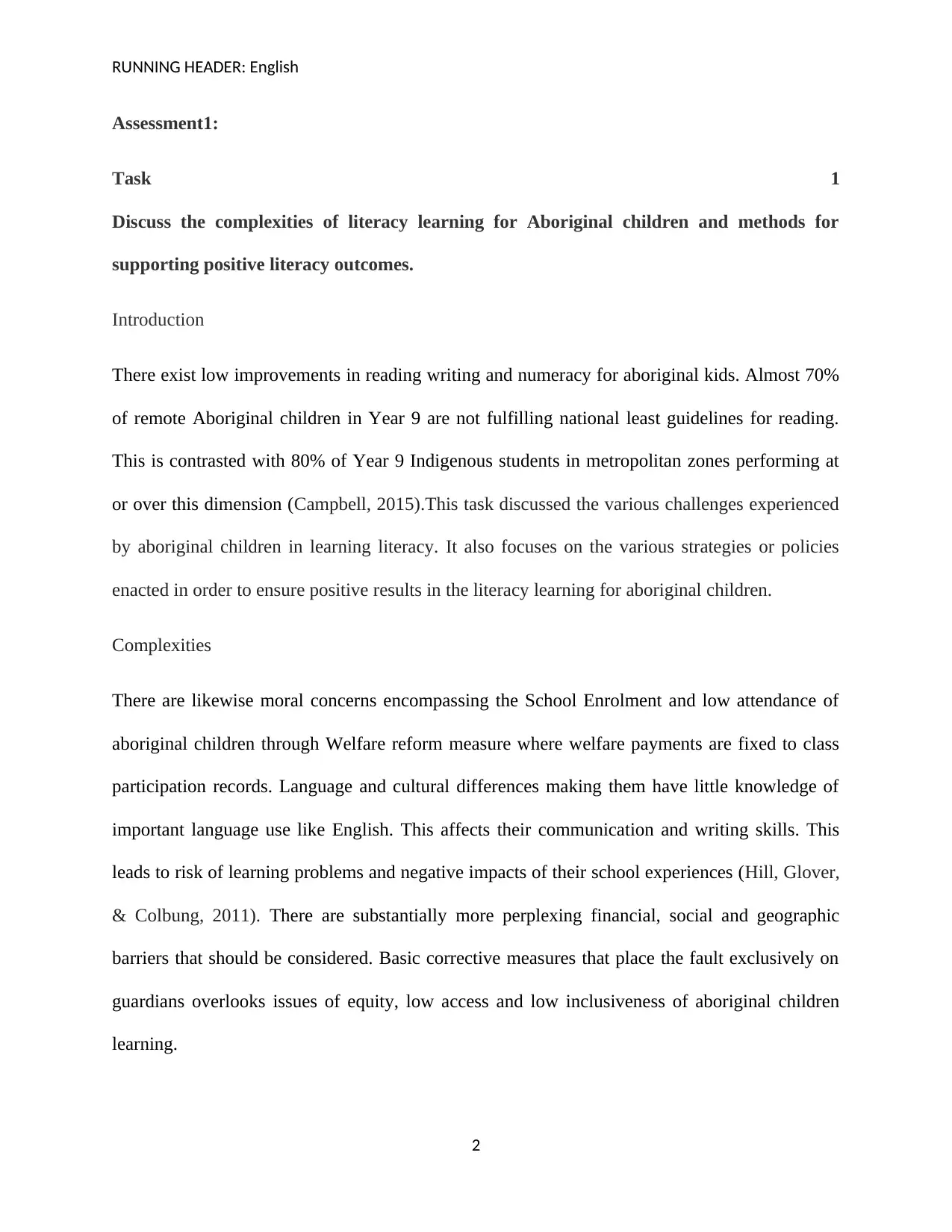
RUNNING HEADER: English
Assessment1:
Task 1
Discuss the complexities of literacy learning for Aboriginal children and methods for
supporting positive literacy outcomes.
Introduction
There exist low improvements in reading writing and numeracy for aboriginal kids. Almost 70%
of remote Aboriginal children in Year 9 are not fulfilling national least guidelines for reading.
This is contrasted with 80% of Year 9 Indigenous students in metropolitan zones performing at
or over this dimension (Campbell, 2015).This task discussed the various challenges experienced
by aboriginal children in learning literacy. It also focuses on the various strategies or policies
enacted in order to ensure positive results in the literacy learning for aboriginal children.
Complexities
There are likewise moral concerns encompassing the School Enrolment and low attendance of
aboriginal children through Welfare reform measure where welfare payments are fixed to class
participation records. Language and cultural differences making them have little knowledge of
important language use like English. This affects their communication and writing skills. This
leads to risk of learning problems and negative impacts of their school experiences (Hill, Glover,
& Colbung, 2011). There are substantially more perplexing financial, social and geographic
barriers that should be considered. Basic corrective measures that place the fault exclusively on
guardians overlooks issues of equity, low access and low inclusiveness of aboriginal children
learning.
2
Assessment1:
Task 1
Discuss the complexities of literacy learning for Aboriginal children and methods for
supporting positive literacy outcomes.
Introduction
There exist low improvements in reading writing and numeracy for aboriginal kids. Almost 70%
of remote Aboriginal children in Year 9 are not fulfilling national least guidelines for reading.
This is contrasted with 80% of Year 9 Indigenous students in metropolitan zones performing at
or over this dimension (Campbell, 2015).This task discussed the various challenges experienced
by aboriginal children in learning literacy. It also focuses on the various strategies or policies
enacted in order to ensure positive results in the literacy learning for aboriginal children.
Complexities
There are likewise moral concerns encompassing the School Enrolment and low attendance of
aboriginal children through Welfare reform measure where welfare payments are fixed to class
participation records. Language and cultural differences making them have little knowledge of
important language use like English. This affects their communication and writing skills. This
leads to risk of learning problems and negative impacts of their school experiences (Hill, Glover,
& Colbung, 2011). There are substantially more perplexing financial, social and geographic
barriers that should be considered. Basic corrective measures that place the fault exclusively on
guardians overlooks issues of equity, low access and low inclusiveness of aboriginal children
learning.
2
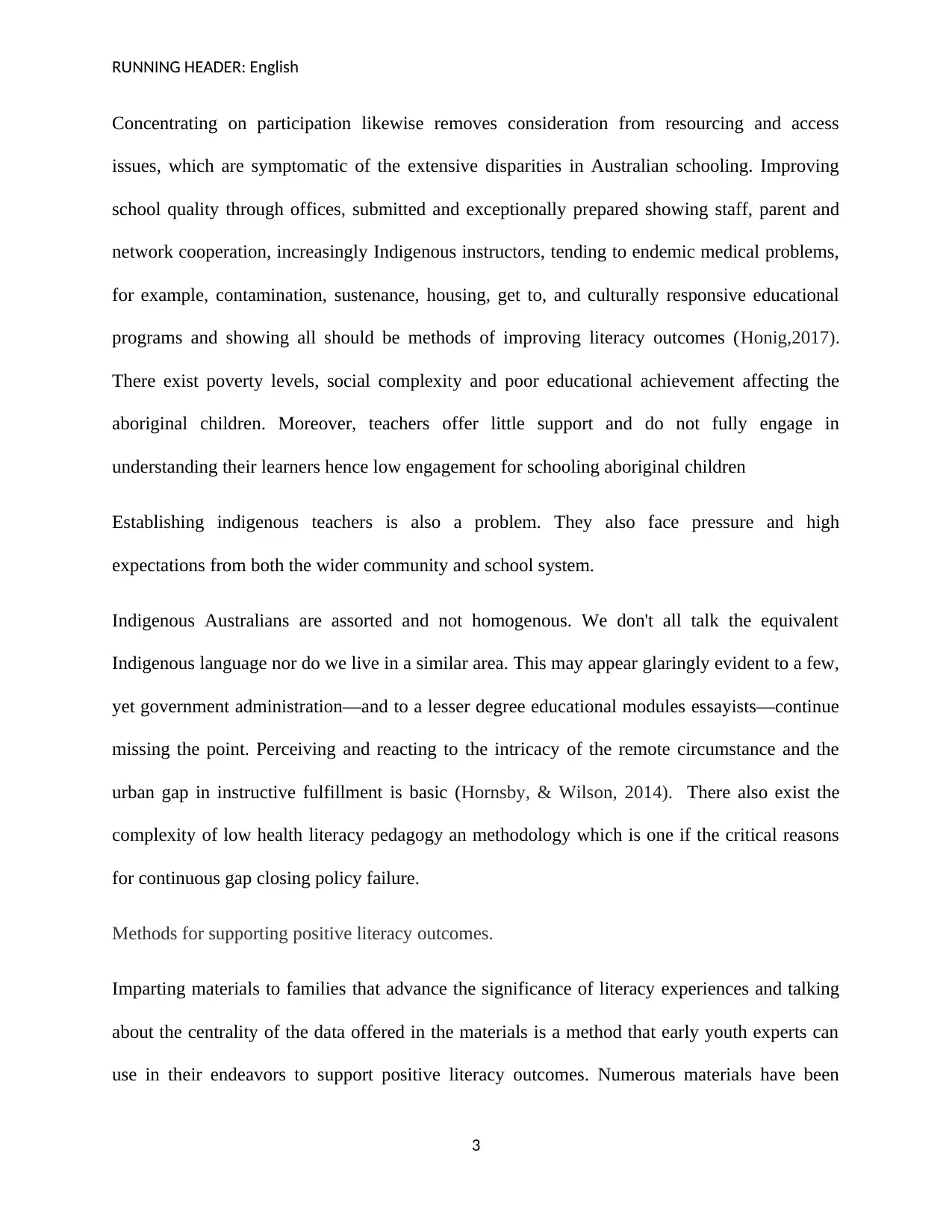
RUNNING HEADER: English
Concentrating on participation likewise removes consideration from resourcing and access
issues, which are symptomatic of the extensive disparities in Australian schooling. Improving
school quality through offices, submitted and exceptionally prepared showing staff, parent and
network cooperation, increasingly Indigenous instructors, tending to endemic medical problems,
for example, contamination, sustenance, housing, get to, and culturally responsive educational
programs and showing all should be methods of improving literacy outcomes (Honig,2017).
There exist poverty levels, social complexity and poor educational achievement affecting the
aboriginal children. Moreover, teachers offer little support and do not fully engage in
understanding their learners hence low engagement for schooling aboriginal children
Establishing indigenous teachers is also a problem. They also face pressure and high
expectations from both the wider community and school system.
Indigenous Australians are assorted and not homogenous. We don't all talk the equivalent
Indigenous language nor do we live in a similar area. This may appear glaringly evident to a few,
yet government administration—and to a lesser degree educational modules essayists—continue
missing the point. Perceiving and reacting to the intricacy of the remote circumstance and the
urban gap in instructive fulfillment is basic (Hornsby, & Wilson, 2014). There also exist the
complexity of low health literacy pedagogy an methodology which is one if the critical reasons
for continuous gap closing policy failure.
Methods for supporting positive literacy outcomes.
Imparting materials to families that advance the significance of literacy experiences and talking
about the centrality of the data offered in the materials is a method that early youth experts can
use in their endeavors to support positive literacy outcomes. Numerous materials have been
3
Concentrating on participation likewise removes consideration from resourcing and access
issues, which are symptomatic of the extensive disparities in Australian schooling. Improving
school quality through offices, submitted and exceptionally prepared showing staff, parent and
network cooperation, increasingly Indigenous instructors, tending to endemic medical problems,
for example, contamination, sustenance, housing, get to, and culturally responsive educational
programs and showing all should be methods of improving literacy outcomes (Honig,2017).
There exist poverty levels, social complexity and poor educational achievement affecting the
aboriginal children. Moreover, teachers offer little support and do not fully engage in
understanding their learners hence low engagement for schooling aboriginal children
Establishing indigenous teachers is also a problem. They also face pressure and high
expectations from both the wider community and school system.
Indigenous Australians are assorted and not homogenous. We don't all talk the equivalent
Indigenous language nor do we live in a similar area. This may appear glaringly evident to a few,
yet government administration—and to a lesser degree educational modules essayists—continue
missing the point. Perceiving and reacting to the intricacy of the remote circumstance and the
urban gap in instructive fulfillment is basic (Hornsby, & Wilson, 2014). There also exist the
complexity of low health literacy pedagogy an methodology which is one if the critical reasons
for continuous gap closing policy failure.
Methods for supporting positive literacy outcomes.
Imparting materials to families that advance the significance of literacy experiences and talking
about the centrality of the data offered in the materials is a method that early youth experts can
use in their endeavors to support positive literacy outcomes. Numerous materials have been
3
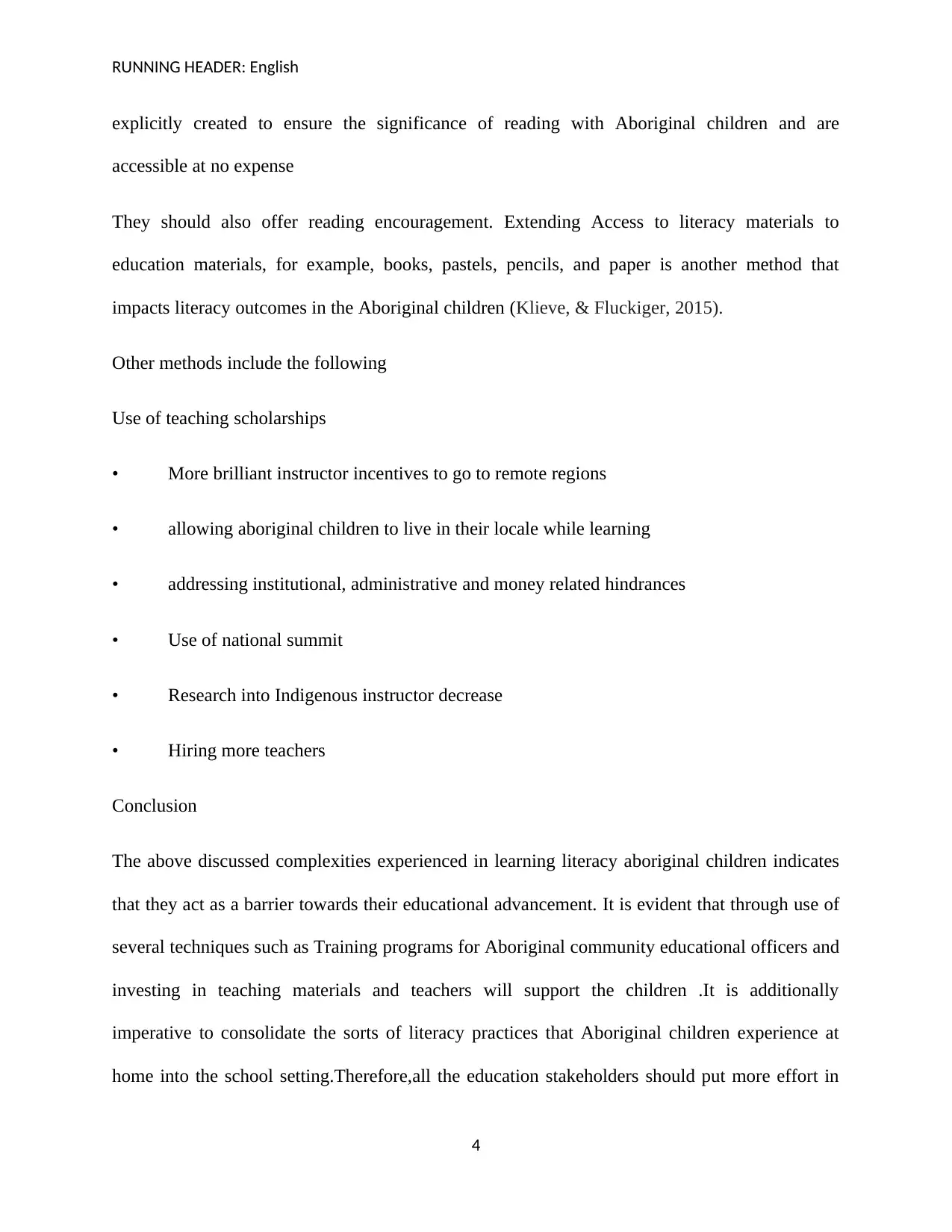
RUNNING HEADER: English
explicitly created to ensure the significance of reading with Aboriginal children and are
accessible at no expense
They should also offer reading encouragement. Extending Access to literacy materials to
education materials, for example, books, pastels, pencils, and paper is another method that
impacts literacy outcomes in the Aboriginal children (Klieve, & Fluckiger, 2015).
Other methods include the following
Use of teaching scholarships
• More brilliant instructor incentives to go to remote regions
• allowing aboriginal children to live in their locale while learning
• addressing institutional, administrative and money related hindrances
• Use of national summit
• Research into Indigenous instructor decrease
• Hiring more teachers
Conclusion
The above discussed complexities experienced in learning literacy aboriginal children indicates
that they act as a barrier towards their educational advancement. It is evident that through use of
several techniques such as Training programs for Aboriginal community educational officers and
investing in teaching materials and teachers will support the children .It is additionally
imperative to consolidate the sorts of literacy practices that Aboriginal children experience at
home into the school setting.Therefore,all the education stakeholders should put more effort in
4
explicitly created to ensure the significance of reading with Aboriginal children and are
accessible at no expense
They should also offer reading encouragement. Extending Access to literacy materials to
education materials, for example, books, pastels, pencils, and paper is another method that
impacts literacy outcomes in the Aboriginal children (Klieve, & Fluckiger, 2015).
Other methods include the following
Use of teaching scholarships
• More brilliant instructor incentives to go to remote regions
• allowing aboriginal children to live in their locale while learning
• addressing institutional, administrative and money related hindrances
• Use of national summit
• Research into Indigenous instructor decrease
• Hiring more teachers
Conclusion
The above discussed complexities experienced in learning literacy aboriginal children indicates
that they act as a barrier towards their educational advancement. It is evident that through use of
several techniques such as Training programs for Aboriginal community educational officers and
investing in teaching materials and teachers will support the children .It is additionally
imperative to consolidate the sorts of literacy practices that Aboriginal children experience at
home into the school setting.Therefore,all the education stakeholders should put more effort in
4
Secure Best Marks with AI Grader
Need help grading? Try our AI Grader for instant feedback on your assignments.
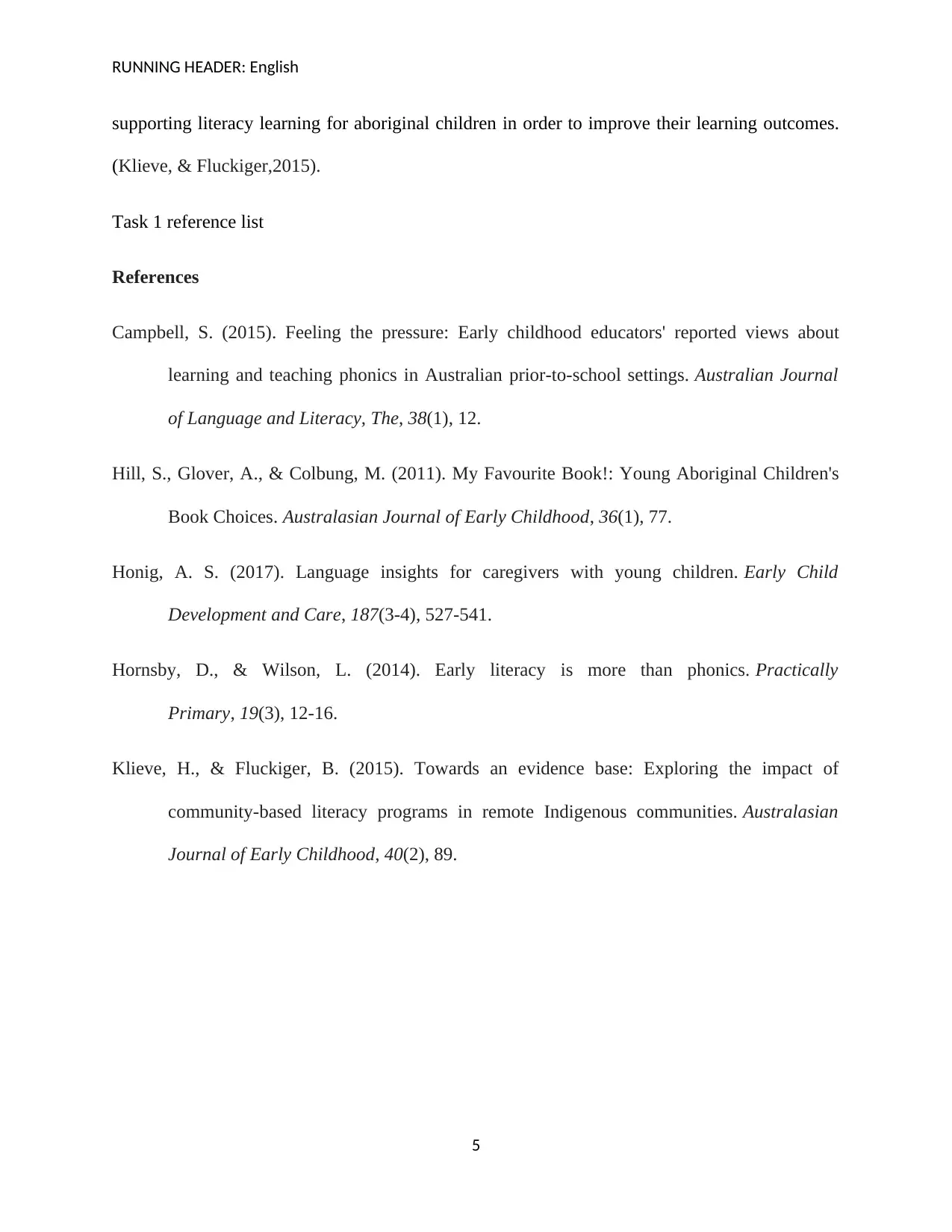
RUNNING HEADER: English
supporting literacy learning for aboriginal children in order to improve their learning outcomes.
(Klieve, & Fluckiger,2015).
Task 1 reference list
References
Campbell, S. (2015). Feeling the pressure: Early childhood educators' reported views about
learning and teaching phonics in Australian prior-to-school settings. Australian Journal
of Language and Literacy, The, 38(1), 12.
Hill, S., Glover, A., & Colbung, M. (2011). My Favourite Book!: Young Aboriginal Children's
Book Choices. Australasian Journal of Early Childhood, 36(1), 77.
Honig, A. S. (2017). Language insights for caregivers with young children. Early Child
Development and Care, 187(3-4), 527-541.
Hornsby, D., & Wilson, L. (2014). Early literacy is more than phonics. Practically
Primary, 19(3), 12-16.
Klieve, H., & Fluckiger, B. (2015). Towards an evidence base: Exploring the impact of
community-based literacy programs in remote Indigenous communities. Australasian
Journal of Early Childhood, 40(2), 89.
5
supporting literacy learning for aboriginal children in order to improve their learning outcomes.
(Klieve, & Fluckiger,2015).
Task 1 reference list
References
Campbell, S. (2015). Feeling the pressure: Early childhood educators' reported views about
learning and teaching phonics in Australian prior-to-school settings. Australian Journal
of Language and Literacy, The, 38(1), 12.
Hill, S., Glover, A., & Colbung, M. (2011). My Favourite Book!: Young Aboriginal Children's
Book Choices. Australasian Journal of Early Childhood, 36(1), 77.
Honig, A. S. (2017). Language insights for caregivers with young children. Early Child
Development and Care, 187(3-4), 527-541.
Hornsby, D., & Wilson, L. (2014). Early literacy is more than phonics. Practically
Primary, 19(3), 12-16.
Klieve, H., & Fluckiger, B. (2015). Towards an evidence base: Exploring the impact of
community-based literacy programs in remote Indigenous communities. Australasian
Journal of Early Childhood, 40(2), 89.
5
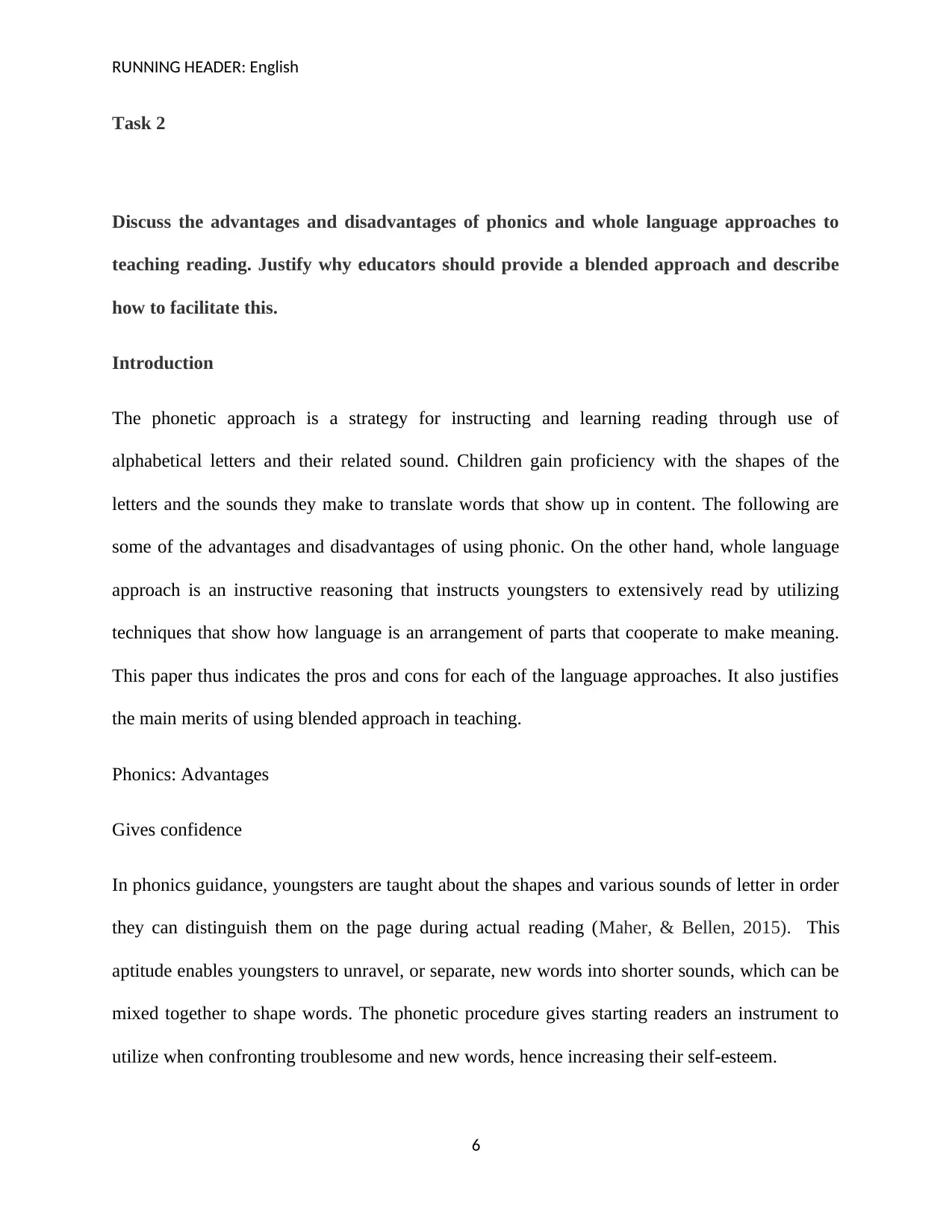
RUNNING HEADER: English
Task 2
Discuss the advantages and disadvantages of phonics and whole language approaches to
teaching reading. Justify why educators should provide a blended approach and describe
how to facilitate this.
Introduction
The phonetic approach is a strategy for instructing and learning reading through use of
alphabetical letters and their related sound. Children gain proficiency with the shapes of the
letters and the sounds they make to translate words that show up in content. The following are
some of the advantages and disadvantages of using phonic. On the other hand, whole language
approach is an instructive reasoning that instructs youngsters to extensively read by utilizing
techniques that show how language is an arrangement of parts that cooperate to make meaning.
This paper thus indicates the pros and cons for each of the language approaches. It also justifies
the main merits of using blended approach in teaching.
Phonics: Advantages
Gives confidence
In phonics guidance, youngsters are taught about the shapes and various sounds of letter in order
they can distinguish them on the page during actual reading (Maher, & Bellen, 2015). This
aptitude enables youngsters to unravel, or separate, new words into shorter sounds, which can be
mixed together to shape words. The phonetic procedure gives starting readers an instrument to
utilize when confronting troublesome and new words, hence increasing their self-esteem.
6
Task 2
Discuss the advantages and disadvantages of phonics and whole language approaches to
teaching reading. Justify why educators should provide a blended approach and describe
how to facilitate this.
Introduction
The phonetic approach is a strategy for instructing and learning reading through use of
alphabetical letters and their related sound. Children gain proficiency with the shapes of the
letters and the sounds they make to translate words that show up in content. The following are
some of the advantages and disadvantages of using phonic. On the other hand, whole language
approach is an instructive reasoning that instructs youngsters to extensively read by utilizing
techniques that show how language is an arrangement of parts that cooperate to make meaning.
This paper thus indicates the pros and cons for each of the language approaches. It also justifies
the main merits of using blended approach in teaching.
Phonics: Advantages
Gives confidence
In phonics guidance, youngsters are taught about the shapes and various sounds of letter in order
they can distinguish them on the page during actual reading (Maher, & Bellen, 2015). This
aptitude enables youngsters to unravel, or separate, new words into shorter sounds, which can be
mixed together to shape words. The phonetic procedure gives starting readers an instrument to
utilize when confronting troublesome and new words, hence increasing their self-esteem.
6
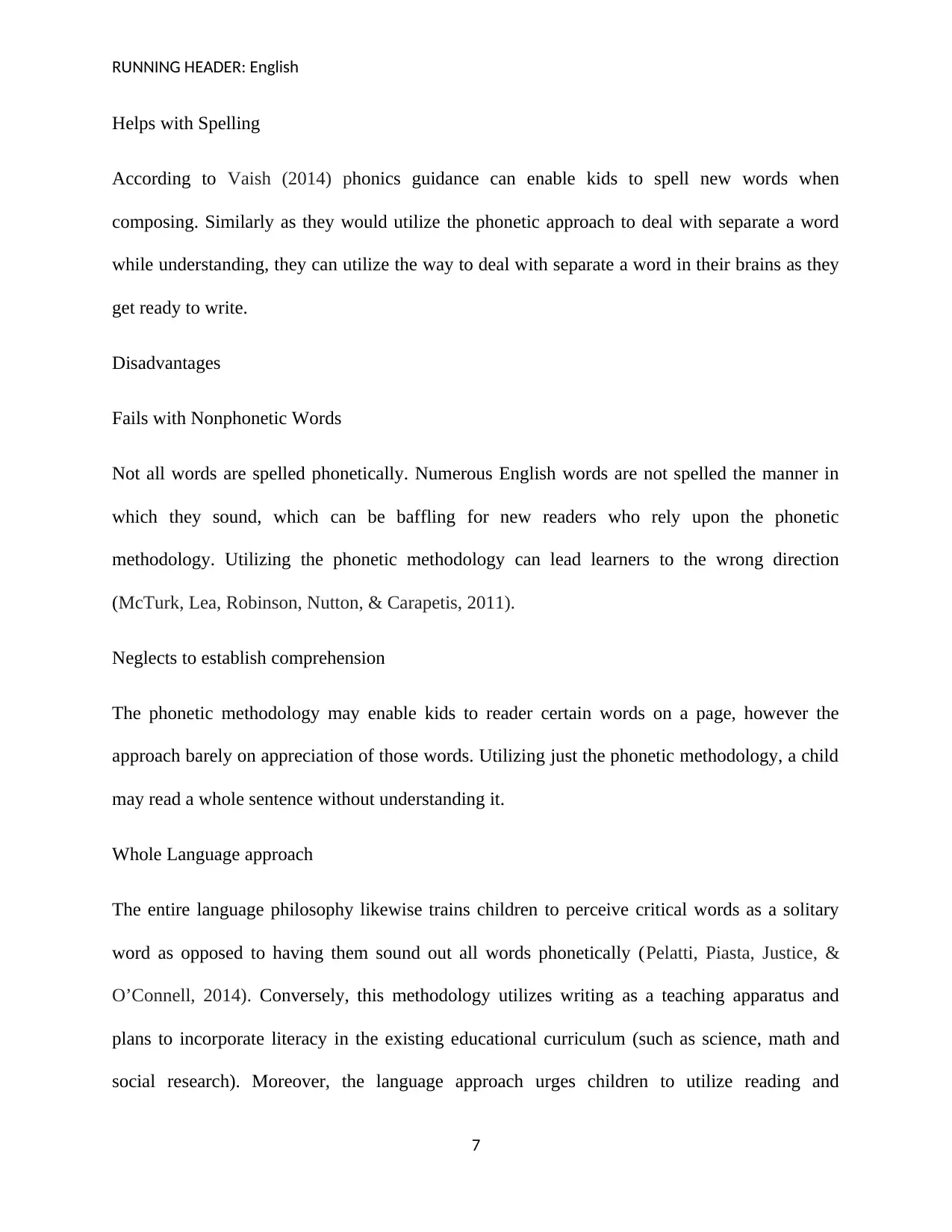
RUNNING HEADER: English
Helps with Spelling
According to Vaish (2014) phonics guidance can enable kids to spell new words when
composing. Similarly as they would utilize the phonetic approach to deal with separate a word
while understanding, they can utilize the way to deal with separate a word in their brains as they
get ready to write.
Disadvantages
Fails with Nonphonetic Words
Not all words are spelled phonetically. Numerous English words are not spelled the manner in
which they sound, which can be baffling for new readers who rely upon the phonetic
methodology. Utilizing the phonetic methodology can lead learners to the wrong direction
(McTurk, Lea, Robinson, Nutton, & Carapetis, 2011).
Neglects to establish comprehension
The phonetic methodology may enable kids to reader certain words on a page, however the
approach barely on appreciation of those words. Utilizing just the phonetic methodology, a child
may read a whole sentence without understanding it.
Whole Language approach
The entire language philosophy likewise trains children to perceive critical words as a solitary
word as opposed to having them sound out all words phonetically (Pelatti, Piasta, Justice, &
O’Connell, 2014). Conversely, this methodology utilizes writing as a teaching apparatus and
plans to incorporate literacy in the existing educational curriculum (such as science, math and
social research). Moreover, the language approach urges children to utilize reading and
7
Helps with Spelling
According to Vaish (2014) phonics guidance can enable kids to spell new words when
composing. Similarly as they would utilize the phonetic approach to deal with separate a word
while understanding, they can utilize the way to deal with separate a word in their brains as they
get ready to write.
Disadvantages
Fails with Nonphonetic Words
Not all words are spelled phonetically. Numerous English words are not spelled the manner in
which they sound, which can be baffling for new readers who rely upon the phonetic
methodology. Utilizing the phonetic methodology can lead learners to the wrong direction
(McTurk, Lea, Robinson, Nutton, & Carapetis, 2011).
Neglects to establish comprehension
The phonetic methodology may enable kids to reader certain words on a page, however the
approach barely on appreciation of those words. Utilizing just the phonetic methodology, a child
may read a whole sentence without understanding it.
Whole Language approach
The entire language philosophy likewise trains children to perceive critical words as a solitary
word as opposed to having them sound out all words phonetically (Pelatti, Piasta, Justice, &
O’Connell, 2014). Conversely, this methodology utilizes writing as a teaching apparatus and
plans to incorporate literacy in the existing educational curriculum (such as science, math and
social research). Moreover, the language approach urges children to utilize reading and
7
Paraphrase This Document
Need a fresh take? Get an instant paraphrase of this document with our AI Paraphraser
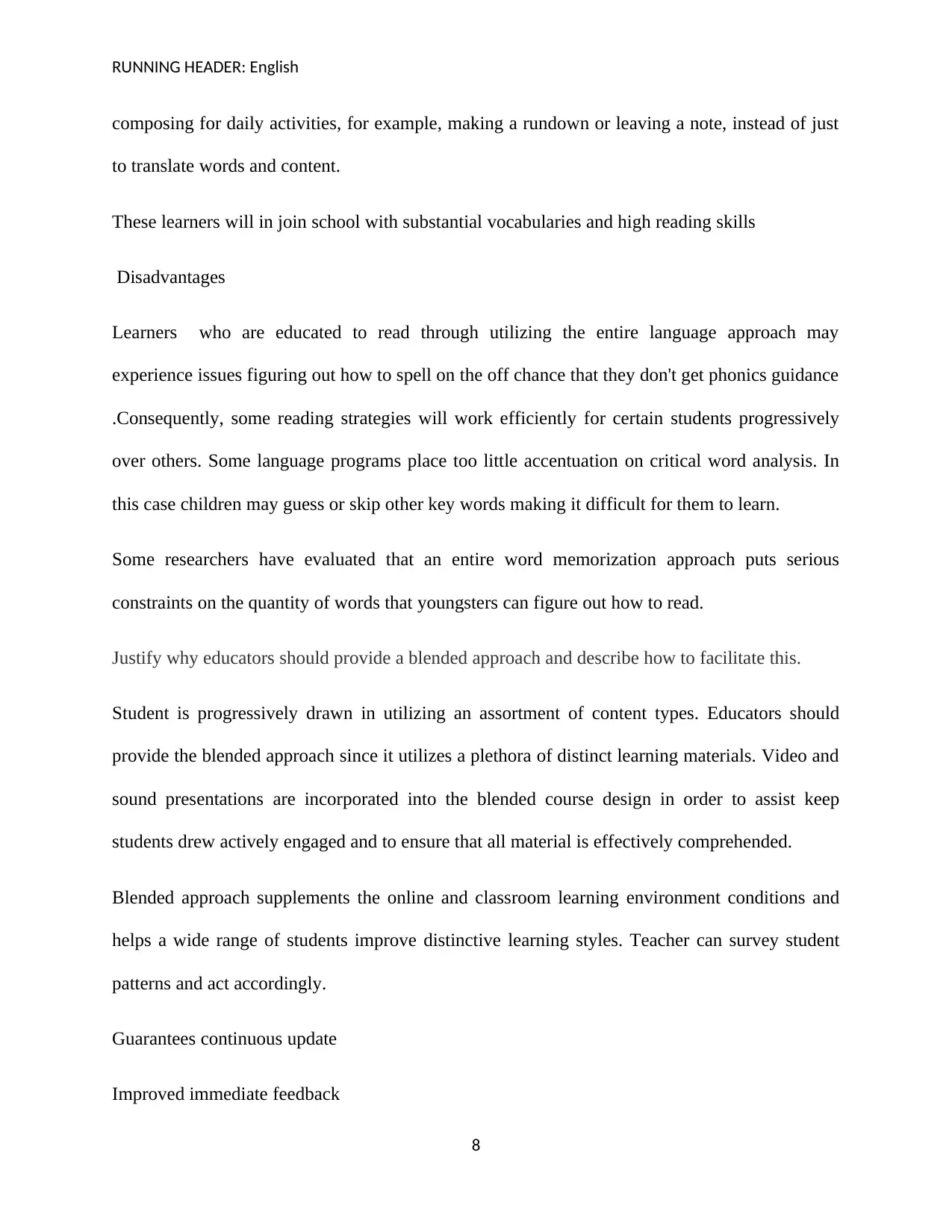
RUNNING HEADER: English
composing for daily activities, for example, making a rundown or leaving a note, instead of just
to translate words and content.
These learners will in join school with substantial vocabularies and high reading skills
Disadvantages
Learners who are educated to read through utilizing the entire language approach may
experience issues figuring out how to spell on the off chance that they don't get phonics guidance
.Consequently, some reading strategies will work efficiently for certain students progressively
over others. Some language programs place too little accentuation on critical word analysis. In
this case children may guess or skip other key words making it difficult for them to learn.
Some researchers have evaluated that an entire word memorization approach puts serious
constraints on the quantity of words that youngsters can figure out how to read.
Justify why educators should provide a blended approach and describe how to facilitate this.
Student is progressively drawn in utilizing an assortment of content types. Educators should
provide the blended approach since it utilizes a plethora of distinct learning materials. Video and
sound presentations are incorporated into the blended course design in order to assist keep
students drew actively engaged and to ensure that all material is effectively comprehended.
Blended approach supplements the online and classroom learning environment conditions and
helps a wide range of students improve distinctive learning styles. Teacher can survey student
patterns and act accordingly.
Guarantees continuous update
Improved immediate feedback
8
composing for daily activities, for example, making a rundown or leaving a note, instead of just
to translate words and content.
These learners will in join school with substantial vocabularies and high reading skills
Disadvantages
Learners who are educated to read through utilizing the entire language approach may
experience issues figuring out how to spell on the off chance that they don't get phonics guidance
.Consequently, some reading strategies will work efficiently for certain students progressively
over others. Some language programs place too little accentuation on critical word analysis. In
this case children may guess or skip other key words making it difficult for them to learn.
Some researchers have evaluated that an entire word memorization approach puts serious
constraints on the quantity of words that youngsters can figure out how to read.
Justify why educators should provide a blended approach and describe how to facilitate this.
Student is progressively drawn in utilizing an assortment of content types. Educators should
provide the blended approach since it utilizes a plethora of distinct learning materials. Video and
sound presentations are incorporated into the blended course design in order to assist keep
students drew actively engaged and to ensure that all material is effectively comprehended.
Blended approach supplements the online and classroom learning environment conditions and
helps a wide range of students improve distinctive learning styles. Teacher can survey student
patterns and act accordingly.
Guarantees continuous update
Improved immediate feedback
8
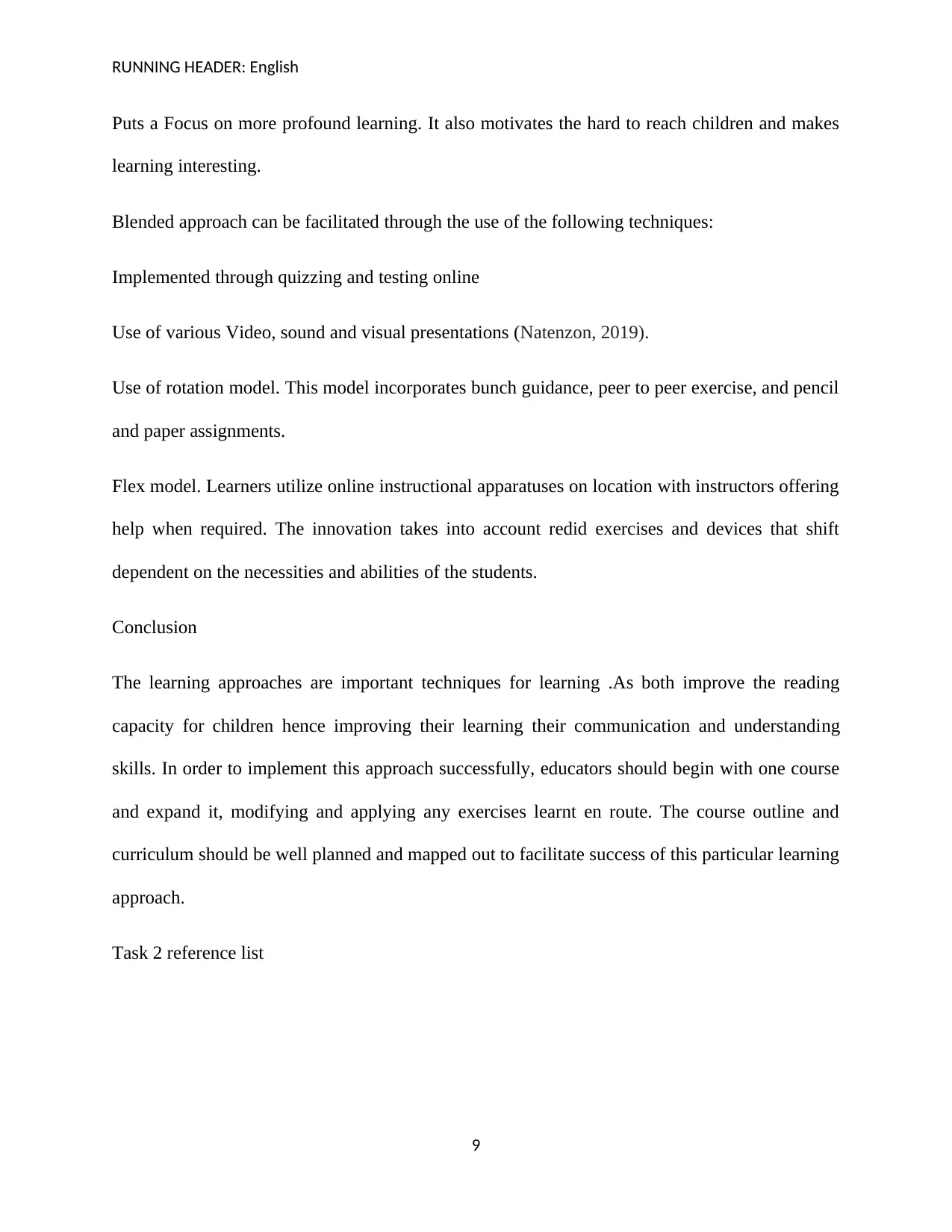
RUNNING HEADER: English
Puts a Focus on more profound learning. It also motivates the hard to reach children and makes
learning interesting.
Blended approach can be facilitated through the use of the following techniques:
Implemented through quizzing and testing online
Use of various Video, sound and visual presentations (Natenzon, 2019).
Use of rotation model. This model incorporates bunch guidance, peer to peer exercise, and pencil
and paper assignments.
Flex model. Learners utilize online instructional apparatuses on location with instructors offering
help when required. The innovation takes into account redid exercises and devices that shift
dependent on the necessities and abilities of the students.
Conclusion
The learning approaches are important techniques for learning .As both improve the reading
capacity for children hence improving their learning their communication and understanding
skills. In order to implement this approach successfully, educators should begin with one course
and expand it, modifying and applying any exercises learnt en route. The course outline and
curriculum should be well planned and mapped out to facilitate success of this particular learning
approach.
Task 2 reference list
9
Puts a Focus on more profound learning. It also motivates the hard to reach children and makes
learning interesting.
Blended approach can be facilitated through the use of the following techniques:
Implemented through quizzing and testing online
Use of various Video, sound and visual presentations (Natenzon, 2019).
Use of rotation model. This model incorporates bunch guidance, peer to peer exercise, and pencil
and paper assignments.
Flex model. Learners utilize online instructional apparatuses on location with instructors offering
help when required. The innovation takes into account redid exercises and devices that shift
dependent on the necessities and abilities of the students.
Conclusion
The learning approaches are important techniques for learning .As both improve the reading
capacity for children hence improving their learning their communication and understanding
skills. In order to implement this approach successfully, educators should begin with one course
and expand it, modifying and applying any exercises learnt en route. The course outline and
curriculum should be well planned and mapped out to facilitate success of this particular learning
approach.
Task 2 reference list
9
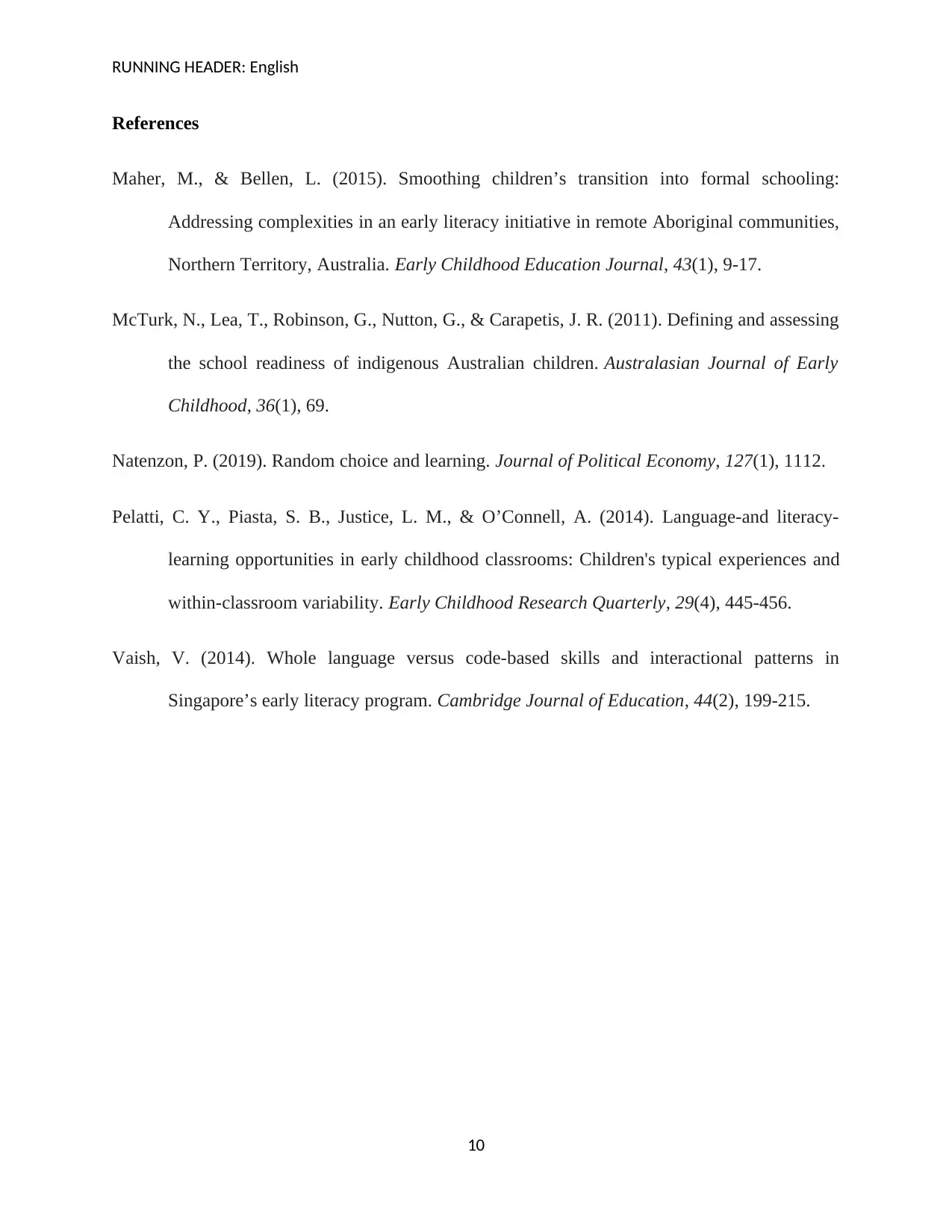
RUNNING HEADER: English
References
Maher, M., & Bellen, L. (2015). Smoothing children’s transition into formal schooling:
Addressing complexities in an early literacy initiative in remote Aboriginal communities,
Northern Territory, Australia. Early Childhood Education Journal, 43(1), 9-17.
McTurk, N., Lea, T., Robinson, G., Nutton, G., & Carapetis, J. R. (2011). Defining and assessing
the school readiness of indigenous Australian children. Australasian Journal of Early
Childhood, 36(1), 69.
Natenzon, P. (2019). Random choice and learning. Journal of Political Economy, 127(1), 1112.
Pelatti, C. Y., Piasta, S. B., Justice, L. M., & O’Connell, A. (2014). Language-and literacy-
learning opportunities in early childhood classrooms: Children's typical experiences and
within-classroom variability. Early Childhood Research Quarterly, 29(4), 445-456.
Vaish, V. (2014). Whole language versus code-based skills and interactional patterns in
Singapore’s early literacy program. Cambridge Journal of Education, 44(2), 199-215.
10
References
Maher, M., & Bellen, L. (2015). Smoothing children’s transition into formal schooling:
Addressing complexities in an early literacy initiative in remote Aboriginal communities,
Northern Territory, Australia. Early Childhood Education Journal, 43(1), 9-17.
McTurk, N., Lea, T., Robinson, G., Nutton, G., & Carapetis, J. R. (2011). Defining and assessing
the school readiness of indigenous Australian children. Australasian Journal of Early
Childhood, 36(1), 69.
Natenzon, P. (2019). Random choice and learning. Journal of Political Economy, 127(1), 1112.
Pelatti, C. Y., Piasta, S. B., Justice, L. M., & O’Connell, A. (2014). Language-and literacy-
learning opportunities in early childhood classrooms: Children's typical experiences and
within-classroom variability. Early Childhood Research Quarterly, 29(4), 445-456.
Vaish, V. (2014). Whole language versus code-based skills and interactional patterns in
Singapore’s early literacy program. Cambridge Journal of Education, 44(2), 199-215.
10
1 out of 10
Related Documents
Your All-in-One AI-Powered Toolkit for Academic Success.
+13062052269
info@desklib.com
Available 24*7 on WhatsApp / Email
![[object Object]](/_next/static/media/star-bottom.7253800d.svg)
Unlock your academic potential
© 2024 | Zucol Services PVT LTD | All rights reserved.





